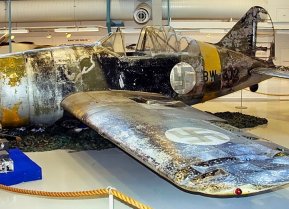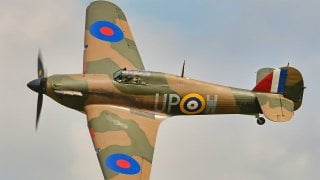Hawker Hurricane: The Fighter That Really Won the Battle of Britain?
The Hawker Hurricane deserves recognition for its contributions to the Battle of Britain and the overall Allied victory in WWII.
When one thinks of Royal Air Force (RAF) fighter planes of WWII, especially the ones that contributed to the defeat of Nazi Germany's Luftwaffe during the Battle of Britain, more than likely the first aircraft that comes to mind is the Supermarine Spitfire. Yet there is that other RAF warbird that, though certainly not forgotten or unsung by professional historians and amateur military aviation history buffs alike, probably deserves a lot more recognition for its contributions to not only the Battle of Britain but the overall Allied victory in the Second World War: the Hawker Hurricane.
As noted by the RAF Museum's official website: "Hurricanes destroyed more enemy aircraft during the Battle of Britain than did all the other air and ground defences combined," (emphasis added).
With that in mind, let's take a deeper dive into the story of this remarkable airplane and give the Hurricane her proper due.
Hearty Hello to the Hawker Hurricane
The Hawker Hurricane was manufactured by Hawker Aircraft Ltd, which is now part of BAE Systems plc – who currently happens to be the lead contractor on Britain's 6th-generation stealth fighter project, the Tempest aka Future Combat Air System, or FCAS. The Hurricane made her maiden flight on November 6, 1935, and was officially introduced into operational service in December 1937. In the process, the plane earned the high praise of test pilot Sammy Wroath, a Flight Sergeant at the time: “The aircraft is simple to fly and has no apparent vices.”
The BAE official website reaffirms FS Wroath's assertions, stating "The Hawker Hurricane proved significantly cheaper to build than the Vickers Supermarine Spitfire as well as being even simpler to overhaul, especially when battle-damage required the urgent attention of the newly-formed, Civil Repair Organisation." In other words, an embodiment of the K.I.S.S. principle, i.e. "Keep It Simple, Stupid."
The plane boasted a max airspeed of 316 mph (509 kph/ 274.59 knots) and a cruise speed of 212 mph (341 kph) with a range of 585 miles (941 kilometers); at the time of the plane's debut, that max speed figure was 100mph (160 kph/ 80.89 knots) faster than any other aircraft in existence. The length was 31 feet 5 inches (9.576 meters), the wingspan was 40 feet, 0 inches (12.192 meters), and those wings bristled with a total of eight Browning .303 Mark II machine guns with 334 rounds of ammunition per gun.
Hurricanes Heed the Call to Arms
When Nazi Germany invaded Poland in September 1939 and thus kicked off the Second World War, the Hurricane was among the first British warplanes to be pressed into duty.
As noted by the official website of the Smithsonian's National Air and Space Museum, "Hurricane pilots drew first blood for the RAF during air battles fought over France. Flying a Hurricane, Pilot Officer P. W. O. Mould of No. 1 Squadron, RAF, destroyed a Dornier Do17 (German twin-engine bomber) on October 30, 1939."
During the Wehrmacht's and Luftwaffe's combined Blitzkrieg against France in 1940, Hurricane drivers fought a valiant and punishing — though ultimately insufficient — rearguard action in which over a quarter of RAF Fighter Command’s aircraft were destroyed.
Of course, as we've already indicated, the Hawker fighter's most important role in World War II came a few months later during the Battle of Britain. To cite the BAE website again, "A total of 1,715 Hawker Hurricanes flew with Fighter Command during the period of the Battle of Britain, far in excess of all other British fighters combined. It is estimated that Hawker Hurricane pilots were credited with four fifths of all enemy aircraft destroyed in that critical period from July to October 1940," (emphasis added). Generally speaking, the Hurricanes and Spitfires divvied up the defensive duties, with the former going after the German bombers whilst the latter tangled with the enemy fighters.
Another bragging right attained by the Hurricane is that the only Victoria Cross awarded to a Fighter Command flyboy was indeed bestowed upon a Hurricane driver, that being Flight Lieutenant James Brindley Eric Nicolson – known as "Bill" to his family and "Nick" to his RAF mates. F/Lt. Nicolson earned the decoration for heroic actions performed on August 16, 1940, and received the decoration directly from His Majesty King George VI at Buckingham Palace on November 25 of that same year.
Hurricanes went on to serve ably for the remainder of the war — though they were gradually switched from pure fighter to mostly fighter-bomber duties. The fighters made significant contributions to the defense of Malta, the desert war in North Africa, and the war against the Japanese in the Far East. The Hawker warbird produced a considerable number of aces, including Flying Officer Edgar James Kain, who became the RAF's very first ace of WWII on March 26, 1940, when he earned his fifth air-to-air kill, this one against a Messerschmitt Bf 109. In addition, Squadron Leader Marmaduke "Pat" Pattle — by some accounts the highest-scoring RAF ace of the war — obtained 35 of his 44 officially confirmed kills – though the tally could actually be as high as 50 – in the Hurricane.
Where Are They Now?
A total of 14,583 Hurricanes were built. Out of the present-day remaining survivors, at least a dozen are airworthy, spread out between Australia, the Czech Republic, Canada, France, the UK, and the United States. To the best of my knowledge, the only airworthy Hurricane that's located Stateside can be found at the Military Aviation Museum in Virginia Beach, Virginia.
About the Author
Christian D. Orr is a former Air Force officer, Federal law enforcement officer, and private military contractor (with assignments worked in Iraq, the United Arab Emirates, Kosovo, Japan, Germany, and the Pentagon). Chris holds a B.A. in International Relations from the University of Southern California (USC) and an M.A. in Intelligence Studies (concentration in Terrorism Studies) from American Military University (AMU). He has also been published in The Daily Torch and The Journal of Intelligence and Cyber Security. Last but not least, he is a Companion of the Order of the Naval Order of the United States (NOUS).


